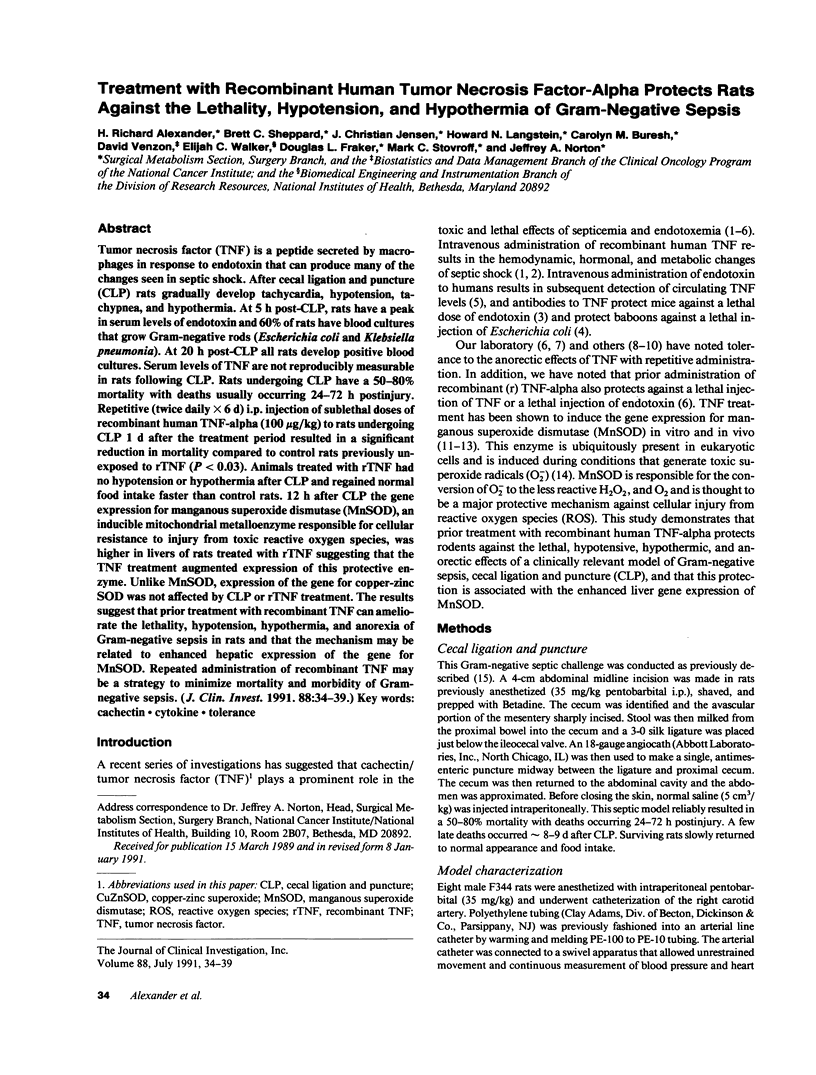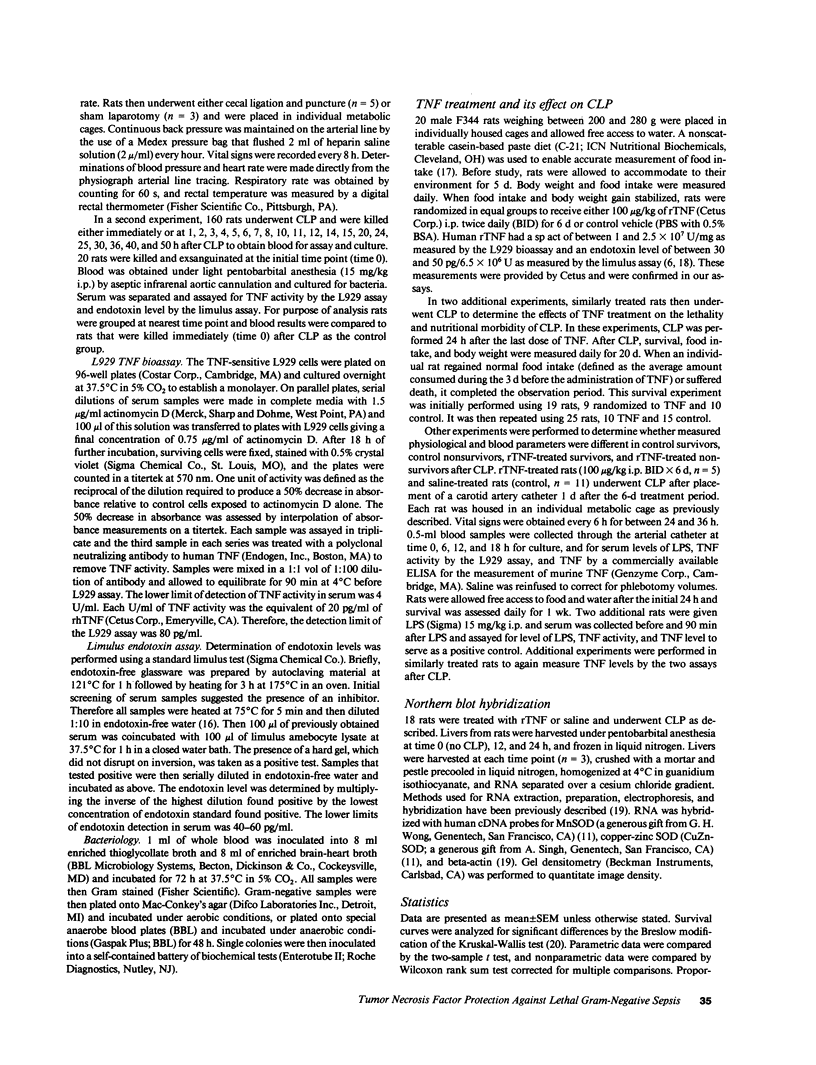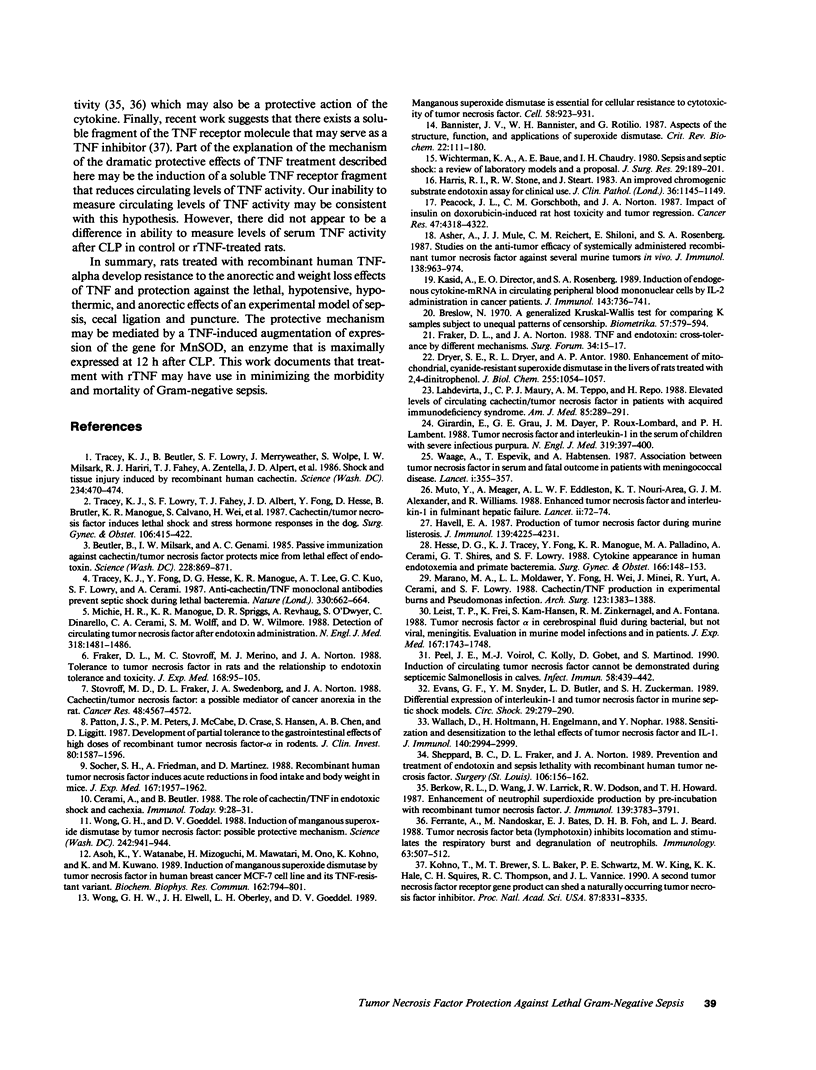Abstract
Tumor necrosis factor (TNF) is a peptide secreted by macrophages in response to endotoxin that can produce many of the changes seen in septic shock. After cecal ligation and puncture (CLP) rats gradually develop tachycardia, hypotension, tachypnea, and hypothermia. At 5 h post-CLP, rats have a peak in serum levels of endotoxin and 60% of rats have blood cultures that grow Gram-negative rods (Escherichia coli and Klebsiella pneumonia). At 20 h post-CLP all rats develop positive blood cultures. Serum levels of TNF are not reproducibly measurable in rats following CLP. Rats undergoing CLP have a 50-80% mortality with deaths usually occurring 24-72 h postinjury. Repetitive (twice daily x 6 d) i.p. injection of sublethal doses of recombinant human TNF-alpha (100 micrograms/kg) to rats undergoing CLP 1 d after the treatment period resulted in a significant reduction in mortality compared to control rats previously unexposed to rTNF (P less than 0.03). Animals treated with rTNF had no hypotension or hypothermia after CLP and regained normal food intake faster than control rats. 12 h after CLP the gene expression for manganous superoxide dismutase (MnSOD), an inducible mitochondrial metalloenzyme responsible for cellular resistance to injury from toxic reactive oxygen species, was higher in livers of rats treated with rTNF suggesting that the TNF treatment augmented expression of this protective enzyme. Unlike MnSOD, expression of the gene for copper-zinc SOD was not affected by CLP or rTNF treatment. The results suggest that prior treatment with recombinant TNF can ameliorate the lethality, hypotension, hypothermia, and anorexia of Gram-negative sepsis in rats and that the mechanism may be related to enhanced hepatic expression of the gene for MnSOD. Repeated administration of recombinant TNF may be a strategy to minimize mortality and morbidity of Gram-negative sepsis.
Full text
PDF





Images in this article
Selected References
These references are in PubMed. This may not be the complete list of references from this article.
- Asher A., Mulé J. J., Reichert C. M., Shiloni E., Rosenberg S. A. Studies on the anti-tumor efficacy of systemically administered recombinant tumor necrosis factor against several murine tumors in vivo. J Immunol. 1987 Feb 1;138(3):963–974. [PubMed] [Google Scholar]
- Asoh K., Watanabe Y., Mizoguchi H., Mawatari M., Ono M., Kohno K., Kuwano M. Induction of manganese superoxide dismutase by tumor necrosis factor in human breast cancer MCF-7 cell line and its TNF-resistant variant. Biochem Biophys Res Commun. 1989 Jul 31;162(2):794–801. doi: 10.1016/0006-291x(89)92380-2. [DOI] [PubMed] [Google Scholar]
- Bannister J. V., Bannister W. H., Rotilio G. Aspects of the structure, function, and applications of superoxide dismutase. CRC Crit Rev Biochem. 1987;22(2):111–180. doi: 10.3109/10409238709083738. [DOI] [PubMed] [Google Scholar]
- Berkow R. L., Wang D., Larrick J. W., Dodson R. W., Howard T. H. Enhancement of neutrophil superoxide production by preincubation with recombinant human tumor necrosis factor. J Immunol. 1987 Dec 1;139(11):3783–3791. [PubMed] [Google Scholar]
- Beutler B., Milsark I. W., Cerami A. C. Passive immunization against cachectin/tumor necrosis factor protects mice from lethal effect of endotoxin. Science. 1985 Aug 30;229(4716):869–871. doi: 10.1126/science.3895437. [DOI] [PubMed] [Google Scholar]
- Cerami A., Beutler B. The role of cachectin/TNF in endotoxic shock and cachexia. Immunol Today. 1988 Jan;9(1):28–31. doi: 10.1016/0167-5699(88)91353-9. [DOI] [PubMed] [Google Scholar]
- Dryer S. E., Dryer R. L., Autor A. P. Enhancement of mitochondrial, cyanide-resistant superoxide dismutase in the livers of rats treated with 2,4-dinitrophenol. J Biol Chem. 1980 Feb 10;255(3):1054–1057. [PubMed] [Google Scholar]
- Evans G. F., Snyder Y. M., Butler L. D., Zuckerman S. H. Differential expression of interleukin-1 and tumor necrosis factor in murine septic shock models. Circ Shock. 1989 Dec;29(4):279–290. [PubMed] [Google Scholar]
- Ferrante A., Nandoskar M., Bates E. J., Goh D. H., Beard L. J. Tumour necrosis factor beta (lymphotoxin) inhibits locomotion and stimulates the respiratory burst and degranulation of neutrophils. Immunology. 1988 Mar;63(3):507–512. [PMC free article] [PubMed] [Google Scholar]
- Fraker D. L., Stovroff M. C., Merino M. J., Norton J. A. Tolerance to tumor necrosis factor in rats and the relationship to endotoxin tolerance and toxicity. J Exp Med. 1988 Jul 1;168(1):95–105. doi: 10.1084/jem.168.1.95. [DOI] [PMC free article] [PubMed] [Google Scholar]
- Girardin E., Grau G. E., Dayer J. M., Roux-Lombard P., Lambert P. H. Tumor necrosis factor and interleukin-1 in the serum of children with severe infectious purpura. N Engl J Med. 1988 Aug 18;319(7):397–400. doi: 10.1056/NEJM198808183190703. [DOI] [PubMed] [Google Scholar]
- Harris R. I., Stone P. C., Stuart J. An improved chromogenic substrate endotoxin assay for clinical use. J Clin Pathol. 1983 Oct;36(10):1145–1149. doi: 10.1136/jcp.36.10.1145. [DOI] [PMC free article] [PubMed] [Google Scholar]
- Havell E. A. Production of tumor necrosis factor during murine listeriosis. J Immunol. 1987 Dec 15;139(12):4225–4231. [PubMed] [Google Scholar]
- Hesse D. G., Tracey K. J., Fong Y., Manogue K. R., Palladino M. A., Jr, Cerami A., Shires G. T., Lowry S. F. Cytokine appearance in human endotoxemia and primate bacteremia. Surg Gynecol Obstet. 1988 Feb;166(2):147–153. [PubMed] [Google Scholar]
- Kasid A., Director E. P., Rosenberg S. A. Induction of endogenous cytokine-mRNA in circulating peripheral blood mononuclear cells by IL-2 administration to cancer patients. J Immunol. 1989 Jul 15;143(2):736–739. [PubMed] [Google Scholar]
- Kohno T., Brewer M. T., Baker S. L., Schwartz P. E., King M. W., Hale K. K., Squires C. H., Thompson R. C., Vannice J. L. A second tumor necrosis factor receptor gene product can shed a naturally occurring tumor necrosis factor inhibitor. Proc Natl Acad Sci U S A. 1990 Nov;87(21):8331–8335. doi: 10.1073/pnas.87.21.8331. [DOI] [PMC free article] [PubMed] [Google Scholar]
- Leist T. P., Frei K., Kam-Hansen S., Zinkernagel R. M., Fontana A. Tumor necrosis factor alpha in cerebrospinal fluid during bacterial, but not viral, meningitis. Evaluation in murine model infections and in patients. J Exp Med. 1988 May 1;167(5):1743–1748. doi: 10.1084/jem.167.5.1743. [DOI] [PMC free article] [PubMed] [Google Scholar]
- Lähdevirta J., Maury C. P., Teppo A. M., Repo H. Elevated levels of circulating cachectin/tumor necrosis factor in patients with acquired immunodeficiency syndrome. Am J Med. 1988 Sep;85(3):289–291. doi: 10.1016/0002-9343(88)90576-1. [DOI] [PubMed] [Google Scholar]
- Marano M. A., Moldawer L. L., Fong Y., Wei H., Minei J., Yurt R., Cerami A., Lowry S. F. Cachectin/TNF production in experimental burns and Pseudomonas infection. Arch Surg. 1988 Nov;123(11):1383–1388. doi: 10.1001/archsurg.1988.01400350097015. [DOI] [PubMed] [Google Scholar]
- Michie H. R., Manogue K. R., Spriggs D. R., Revhaug A., O'Dwyer S., Dinarello C. A., Cerami A., Wolff S. M., Wilmore D. W. Detection of circulating tumor necrosis factor after endotoxin administration. N Engl J Med. 1988 Jun 9;318(23):1481–1486. doi: 10.1056/NEJM198806093182301. [DOI] [PubMed] [Google Scholar]
- Muto Y., Nouri-Aria K. T., Meager A., Alexander G. J., Eddleston A. L., Williams R. Enhanced tumour necrosis factor and interleukin-1 in fulminant hepatic failure. Lancet. 1988 Jul 9;2(8602):72–74. doi: 10.1016/s0140-6736(88)90006-2. [DOI] [PubMed] [Google Scholar]
- Patton J. S., Peters P. M., McCabe J., Crase D., Hansen S., Chen A. B., Liggitt D. Development of partial tolerance to the gastrointestinal effects of high doses of recombinant tumor necrosis factor-alpha in rodents. J Clin Invest. 1987 Dec;80(6):1587–1596. doi: 10.1172/JCI113245. [DOI] [PMC free article] [PubMed] [Google Scholar]
- Peacock J. L., Gorschboth C. M., Norton J. A. Impact of insulin on doxorubicin-induced rat host toxicity and tumor regression. Cancer Res. 1987 Aug 15;47(16):4318–4322. [PubMed] [Google Scholar]
- Peel J. E., Voirol M. J., Kolly C., Gobet D., Martinod S. Induction of circulating tumor necrosis factor cannot be demonstrated during septicemic salmonellosis in calves. Infect Immun. 1990 Feb;58(2):439–442. doi: 10.1128/iai.58.2.439-442.1990. [DOI] [PMC free article] [PubMed] [Google Scholar]
- Sheppard B. C., Fraker D. L., Norton J. A. Prevention and treatment of endotoxin and sepsis lethality with recombinant human tumor necrosis factor. Surgery. 1989 Aug;106(2):156–162. [PubMed] [Google Scholar]
- Socher S. H., Friedman A., Martinez D. Recombinant human tumor necrosis factor induces acute reductions in food intake and body weight in mice. J Exp Med. 1988 Jun 1;167(6):1957–1962. doi: 10.1084/jem.167.6.1957. [DOI] [PMC free article] [PubMed] [Google Scholar]
- Stovroff M. C., Fraker D. L., Swedenborg J. A., Norton J. A. Cachectin/tumor necrosis factor: a possible mediator of cancer anorexia in the rat. Cancer Res. 1988 Aug 15;48(16):4567–4572. [PubMed] [Google Scholar]
- Tracey K. J., Beutler B., Lowry S. F., Merryweather J., Wolpe S., Milsark I. W., Hariri R. J., Fahey T. J., 3rd, Zentella A., Albert J. D. Shock and tissue injury induced by recombinant human cachectin. Science. 1986 Oct 24;234(4775):470–474. doi: 10.1126/science.3764421. [DOI] [PubMed] [Google Scholar]
- Tracey K. J., Fong Y., Hesse D. G., Manogue K. R., Lee A. T., Kuo G. C., Lowry S. F., Cerami A. Anti-cachectin/TNF monoclonal antibodies prevent septic shock during lethal bacteraemia. Nature. 1987 Dec 17;330(6149):662–664. doi: 10.1038/330662a0. [DOI] [PubMed] [Google Scholar]
- Tracey K. J., Lowry S. F., Fahey T. J., 3rd, Albert J. D., Fong Y., Hesse D., Beutler B., Manogue K. R., Calvano S., Wei H. Cachectin/tumor necrosis factor induces lethal shock and stress hormone responses in the dog. Surg Gynecol Obstet. 1987 May;164(5):415–422. [PubMed] [Google Scholar]
- Waage A., Halstensen A., Espevik T. Association between tumour necrosis factor in serum and fatal outcome in patients with meningococcal disease. Lancet. 1987 Feb 14;1(8529):355–357. doi: 10.1016/s0140-6736(87)91728-4. [DOI] [PubMed] [Google Scholar]
- Wallach D., Holtmann H., Engelmann H., Nophar Y. Sensitization and desensitization to lethal effects of tumor necrosis factor and IL-1. J Immunol. 1988 May 1;140(9):2994–2999. [PubMed] [Google Scholar]
- Wichterman K. A., Baue A. E., Chaudry I. H. Sepsis and septic shock--a review of laboratory models and a proposal. J Surg Res. 1980 Aug;29(2):189–201. doi: 10.1016/0022-4804(80)90037-2. [DOI] [PubMed] [Google Scholar]
- Wong G. H., Elwell J. H., Oberley L. W., Goeddel D. V. Manganous superoxide dismutase is essential for cellular resistance to cytotoxicity of tumor necrosis factor. Cell. 1989 Sep 8;58(5):923–931. doi: 10.1016/0092-8674(89)90944-6. [DOI] [PubMed] [Google Scholar]
- Wong G. H., Goeddel D. V. Induction of manganous superoxide dismutase by tumor necrosis factor: possible protective mechanism. Science. 1988 Nov 11;242(4880):941–944. doi: 10.1126/science.3263703. [DOI] [PubMed] [Google Scholar]



